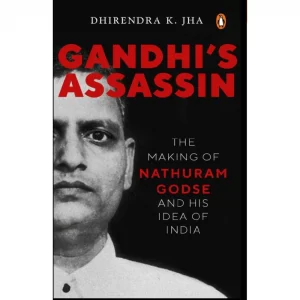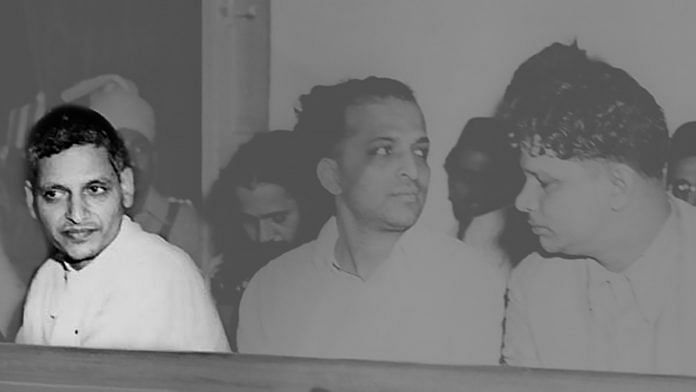After Gandhi toured the riot-hit areas of Calcutta and Noakhali in Bengal and from there to Bihar during November 1946 and March 1947, the lead headline of Agrani published on 12 April 1947 was: ‘The Thirst for Blood of the Advocate of Non-violence has not been Quenched’. The article declared that ‘Gandhiji is anxious to see Mr. Jinnah the first president of India’. It also said that Gandhi was ‘not satisfied with the bloodshed of Hindus’ and that he wanted ‘more bloodshed and massacre of Hindus’.
Another article in the same issue said Gandhi was ‘asking Hindus to be non-violent so that they should not take objection to remain under the rule of Jinnah or Muslim League’. Yet another article in the same issue of Agrani had the heading: ‘Gandhi, Commit Suicide’. The article asked Gandhi to ‘commit suicide’ or ‘withdraw himself from the Indian politics’ and said that ‘it is utter shamelessness that a coward person who always moves under the police and military escort should ask the Hindus to sacrifice themselves without defending’. The article added that ‘those who do not wish to have bloodshed in India should disregard Gandhiji’s suicidal advice and should chalk out a new policy suitable to the present society’.
Articles that Godse wrote in Agrani left no doubt about what he was against, although there was still considerable doubt about what he was for. He was gravitating towards his destiny, and quite fast at that.
Godse expressed his new self-confidence in a bold and provocative gesture: he whipped out a knife and tried to stab Hindu Mahasabha president L.B. Bhopatkar in December 1946 when he felt the party was not honouring his wishes. Godse’s outburst coincided with his rising irritation at a time when the partition of India became inevitable and the Mahasabha decided to join the provisional government headed by Nehru. The provisional government had been set up in September 1946 from among the members of the Constituent Assembly elected early that year. This government was to ensure smooth transition from British rule to Independence.
Also read: When Gandhi murder investigator got on the same taxi Godse and others took
Godse believed that the Hindu Mahasabha should stay away from the government led by Nehru. Perhaps he felt that by joining the government the Mahasabha would deviate from its special mission of converting India into a Hindu rashtra. He, therefore, resented the party’s decision to let its leader, Mukherjee, accept a seat in the Nehru cabinet. When a resolution to this effect was moved by Bhopatkar at the Barshi session of the Maharashtra provincial Hindu Mahasabha, Godse pulled out a knife in anger. The conference was held between 13 and 16 December 1946.
Though Apte backed him, Godse could not make common cause with most of the party leaders, who seemed to fear being left out at a time when the limelight was set to shift to the provisional government leading the transition to Independence. Perhaps it was the insecurity of his situation that forced Godse to take a violently antagonistic position, for the idea of reconciliation implicit in the Hindu Mahasabha resolution threatened to rob him of the sense of purpose critical for his own existence.
Also read: Godse was ‘yearning’ for Savarkar’s support in Gandhi murder trial court. But it never came
Godse’s obstructionist tactics did not work. His act and his extremist position annoyed many leaders attending the conference. The resolution was adopted and Mukherjee was allowed to join the provisional government.
However, Godse, who had worked himself into an almost hopeless position, refused to back down. Now he shifted his focus to what he seemed to have thought an imminent showdown, under the leadership of Savarkar, with the Congress and Gandhi for the setting up of a Hindu rashtra. Already, months before the Barshi session, Savarkar, addressing a group of around fifty swayamsevaks of the HRD at his residence in Bombay, had called for preparations to boycott Muslims in all forms and to retaliate against ‘aggression’ by them. Once isolated in the Mahasabha at its Barshi session, Godse might just have lost faith in the party’s ability to convert India into a Hindu rashtra, and this might have heralded his shift from collective action to individual acts to achieve the goal. It is possible that with this transition, he came to regard himself as the saviour the Hindus awaited.
Though the communal tension had not yet reached the grotesque extremes of August 1947, it had already led to the virtual collapse of religious harmony in several parts of India. In a gradual but very concrete way the communalists of both sides were spreading venom, thus reinforcing each other’s prejudices and hatred. Maharashtra was not the focal point of these tensions but, in view of the determined efforts by various organizations and individuals to target Muslims, it was unlikely that the calm would remain for long.
 This excerpt from ‘Gandhi’s Assassin: The Making of Nathuram Godse and His Idea of India’ by Dhirendra Jha has been published with permission from Penguin Random House India.
This excerpt from ‘Gandhi’s Assassin: The Making of Nathuram Godse and His Idea of India’ by Dhirendra Jha has been published with permission from Penguin Random House India.



